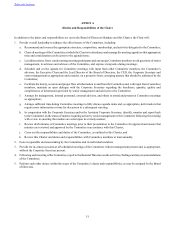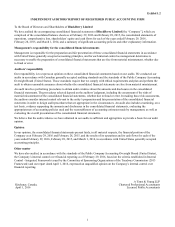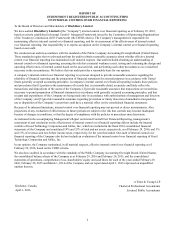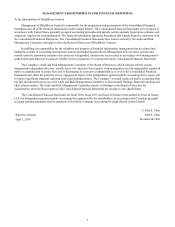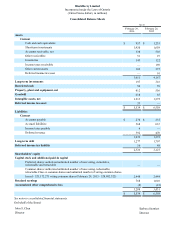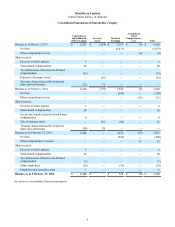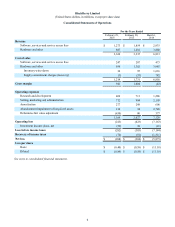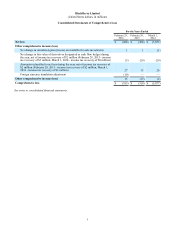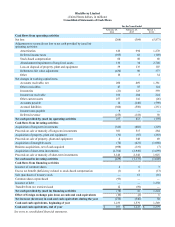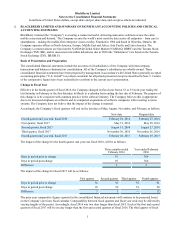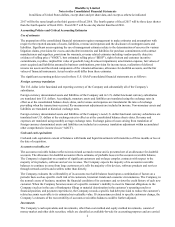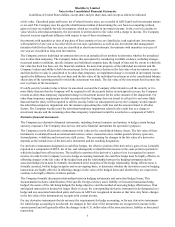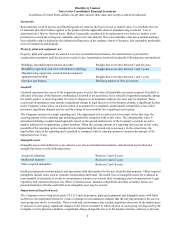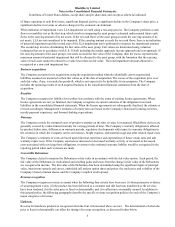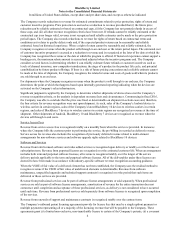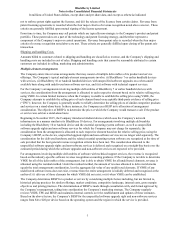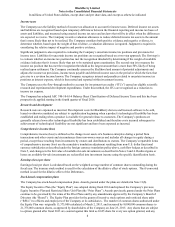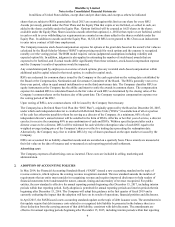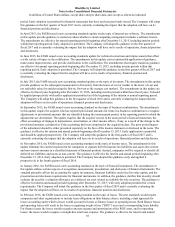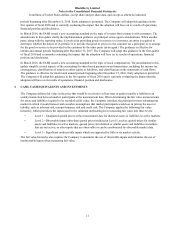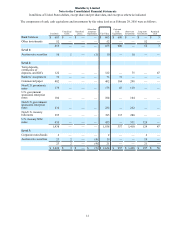Blackberry 2016 Annual Report Download - page 70
Download and view the complete annual report
Please find page 70 of the 2016 Blackberry annual report below. You can navigate through the pages in the report by either clicking on the pages listed below, or by using the keyword search tool below to find specific information within the annual report.BlackBerry Limited
Notes to the Consolidated Financial Statements
In millions of United States dollars, except share and per share data, and except as otherwise indicated
2
2017 will be the same length as the third quarter of fiscal 2016. The fourth quarter of fiscal 2017 will be three days shorter
than the fourth quarter of fiscal 2016. Fiscal 2017 will be one day shorter than fiscal 2016.
Accounting Policies and Critical Accounting Estimates
Use of estimates
The preparation of the consolidated financial statements requires management to make estimates and assumptions with
respect to the reported amounts of assets, liabilities, revenue and expenses and the disclosure of contingent assets and
liabilities. Significant areas requiring the use of management estimates relate to the determination of reserves for various
litigation claims, provisions for excess and obsolete inventories and liabilities for purchase commitments with contract
manufacturers and suppliers, provisions for warranty, revenue related estimates including vendor-specific objective
evidence of selling price (“VSOE”), best estimated selling price (“BESP”), right of return and customer incentive
commitments, royalties, implied fair value of goodwill, long-lived asset impairment, amortization expense, fair values of
assets acquired and liabilities assumed in business combinations, provision for income taxes, realization of deferred
income tax assets and the related components of the valuation allowance, allowance for doubtful accounts, and the fair
values of financial instruments. Actual results could differ from these estimates.
The significant accounting policies used in these U.S. GAAP consolidated financial statements are as follows:
Foreign currency translation
The U.S. dollar is the functional and reporting currency of the Company and substantially all of the Company’s
subsidiaries.
Foreign currency denominated assets and liabilities of the Company and its U.S. dollar functional currency subsidiaries
are translated into U.S. dollars. Accordingly, monetary assets and liabilities are translated using the exchange rates in
effect as at the consolidated balance sheets dates, and revenues and expenses are translated at the rates of exchange
prevailing when the transactions occurred. Re-measurement adjustments are included in income. Non-monetary assets and
liabilities are translated at historical exchange rates.
Foreign currency denominated assets and liabilities of the Company’s non-U.S. dollar functional currency subsidiaries are
translated into U.S. dollars at the exchange rates in effect as at the consolidated balance sheets dates. Revenue and
expenses are translated using monthly average exchange rates. Exchange gains or losses arising from translation of
foreign currency denominated assets and liabilities are included as a currency translation adjustment within accumulated
other comprehensive income (loss) (“AOCI”).
Cash and cash equivalents
Cash and cash equivalents consist of balances with banks and liquid investments with maturities of three months or less at
the date of acquisition.
Accounts receivable, net
The accounts receivable balance reflects invoiced and accrued revenue and is presented net of an allowance for doubtful
accounts. The allowance for doubtful accounts reflects estimates of probable losses in the accounts receivable balance.
The Company is dependent on a number of significant customers and on large complex contracts with respect to the
majority of its products, software and service revenue. The Company expects the majority of its accounts receivable
balances to continue to come from large customers as it sells the majority of its devices, software products and services
through network carriers and resellers rather than directly.
The Company evaluates the collectability of its accounts receivable balance based upon a combination of factors on a
periodic basis such as specific credit risk of its customers, historical trends and economic circumstances. The Company, in
the normal course of business, monitors the financial condition of its customers and reviews the credit history of each new
customer. When the Company becomes aware of a specific customer’s inability to meet its financial obligations to the
Company (such as in the case of bankruptcy filings or material deterioration in the customer’s operating results or
financial position, and payment experiences), the Company records a specific bad debt provision to reduce the customer’s
related accounts receivable to its estimated net realizable value. If circumstances related to specific customers change, the
Company’s estimates of the recoverability of accounts receivables balances could be further adjusted.
Investments
The Company’s cash equivalents and investments, other than cost method and equity method investments, consist of
money market and other debt securities, which are classified as available-for-sale for accounting purposes and are carried


